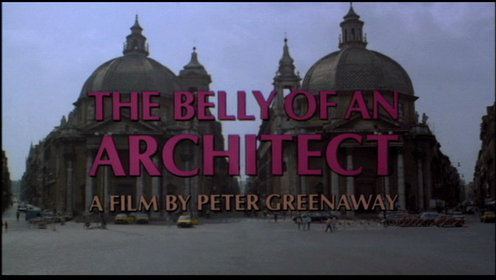| |
The
pairs of students below are assigned a pair of images from the film, plus
a keyword or set of keywords. Don't consider yourself limited to referring
to the images assigned (I only have so much space) as there are many more
from the film that could be added to your clue set. Make sure you look
at the images BELOW your names.
You are NOT
to confer ahead of time. Prepare your discussion (keep it to less than
400 words please) based on the frame of reference, I have been there
or I have not been there. You will both be giving answers in
class and we will be comparing the nature of the answer to see how it
relates to the impressions of the film based upon personal experience
of a place, or lack thereof.
Special
question for the Italian students. |
|
| |
1.
Chang,
Clementine
+ Armstrong, Anne-Marie -- foreshadowing |
|
| |
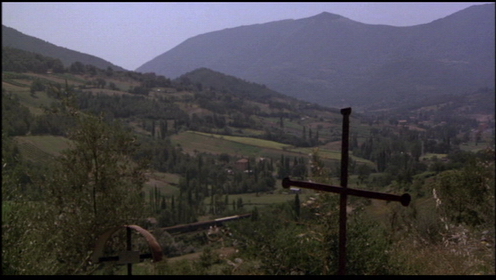 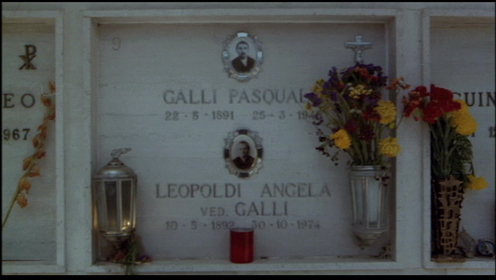
Clementine
Chang:
The Belly
of an Architect is visually stimulating and memorable, which works extremely
well where the technique of foreshadowing is employed. Early scenes are
composed to leave vivid marks in the viewer’s memory by using strong
symmetry, recurring geometry and the general impressive ways of Rome.
For example,
the opening scenes cleverly foreshadowed Stourley Kracklite’s inevitably
destiny. On the train into Rome, the scenery of the hillside cemetery
sprinkled with the many crucifixes created a feeling of unease. From that
point onwards, the viewer anticipates conflict and chaos to erupt. The
film comes full circle at the end when Stourley falls out the window to
end his life. He does so in a Christ-like position echoing the crucifixes
from the start of the film.
Throughout
the entire film, the recurrence of round forms is evident. They allude
to the spherical constructions designed by Etienne-Louis Boullée
and form strong impressions on the viewer early in the film. The beginning
scene of Stourley lying down with his dome-shaped belly clearly displayed
after making love to his wife introduces a chain of round forms to come.
The dome-shaped cake at the first dinner in front of the Pantheon is one
example. In fact, the Pantheon itself also served to remind the viewer
of round forms, even without actually revealing its famous dome. The image
of the crumbled dome cake foreshadowed the deterioration of Stourley,
soon to be manifested by his stomach pains. Further, Louisa’s pregnant
belly also contributes to the list of recurring round forms. The parallel
timing of Stourley’s death cycle and his child’s birth cycle
worked to foreshadow each other simultaneously, as the plot yearns for
an instinctual balance of events.
Anne-Marie Armstrong:
Richly symbolic
imagery provides The Belly of An Architect with several opportunities
to employ foreshadowing, which is accomplished through the employment
of shifts in scale from the strong geometry or symbols presented towards
the films focus, Kracklite.
The film
opens with images pertaining to death, in the form of several crucifixes,
set against the landscape, followed by the scale shift to that of two
gravesites, displaying photographs of the deceased. These images immediately
speak to the viewer of the potential for tragedy to unfold. Retaining
the memory of these two images, we are next introduced to Kracklite in
the throes of a sexual encounter with his wife on his way into Italy by
train, traveling through the landscape towards the city. As an audience,
we are presented with the round spherical ‘dome’ that is his
stomach. Retaining the memory of the two initial images and connecting
them to the introduction of the protagonist, the film foreshadows Kracklite’s
ultimate and painful struggle and his eventual demise due to a cancer
of the stomach.
The aforementioned
image of Kracklite’s prominent paunch becomes the focus of the film
as it unfolds. The image of the Pantheon, of which a dome-shaped cake
is set against, connects again, abstractly, back to the form of Kracklite.
Thus, when the cake is ultimately abandoned in a state of ruin, we are
able to make connections back to Kracklite and his destiny. This is reinforced
later in the film, because shortly after this scene, Kracklite begins
to deteriorate, he begins to suffer from excruciating stomach pains, vomiting
everytime he eats.
|
|
| |
2. Cichy,
Mark
+ Bedard, Joshua -- symmetry of "place"
|
|
| |
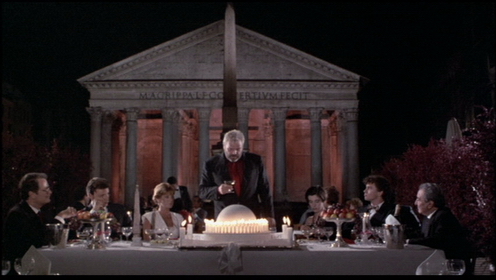
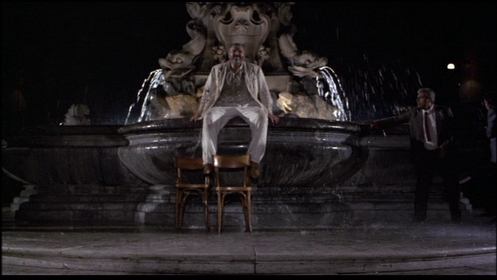
Mark Cichy:
The
symmetry of the Pantheon is striking, the execution, given its massive
scale – breathtaking. My memory of this well known relic was made
all the more intimate by the enormous amount of time I spent sketching
and photographing every crevice of her beauty. My intention was to create
a digital version that would compliment its precision. I was humbled by
the complexity of what appeared to be an incredibly simple parti. Incredibly
ornate, yet restrained, the parti was so simple, a sphere inside a box
– a figure of accuracy. Eventually I became asphyxiated in its complexity
and abandoned the project in the best interest of my sanity.
The
sheer scale was astonishing, the tactility of the stone smooth and silky.
The pediment stood proud amongst the piazza, it seemed to float amongst
the clouds, engrained in the stone, a tribute to Marcus Agrippa. The forest
of columns amid the entrance were incomprehensible, pictures do not even
begin to describe the sheer mass they possessed. Clasping my arms against
them barely even accounted for one-eighth their circumference. The stone
was cool, yet comforting; the veins were worn and smooth. I spent hours
studying the structure supporting the pediment, massive wooden beams,
thousands of years old, yet still as strong as the day they were placed.
The doors
were astonishing, also enormous in scale, they required the strength of
at least three or four men to open or close. The iron that protruded was
worn from centuries of use. The hinges were about the length of my leg!
The wood itself was magnificently intact and un-weathered. The entrance
made you feel like you were entering a sanctuary built for the gods.
The first
spectacle that demands your attention upon entering is the intense glow
of the sun streaming in through the oculus above. Its beauty is both breathtaking
and mesmerizing; I stood there for hours, starring as the world continued
to move around me. The coffered ceiling had such depth and created such
striking shadow lines; if I were to reach out my hand I could have felt
the touch of the cold shadowy stone above. The sheer precision and placement
of the drainage wholes in the floor were astonishing, maybe more so, the
fact that they were even conceived of at all. Standing in the centre was
like standing at the centre of the universe; and reaching into the centre
when rain was coming through the oculus was an especially serendipitous
event. It was amazing to see the rain concentrated and controlled at such
a large diameter. Amongst the midst of the restoration were still pieces
that showed their original state. At the base of the dome was a fabulous
colonnade, although rhythmic in progression, this apparently had been
altered over time. Beneath the colonnade, were large vertical columns;
between the columns, the tomb of the Rafael and several other kings. Finally
the alter, stood directly opposite the entrance; in front were about fifty
carefully placed chairs, fenced off with red velvet ropes and remarkably
shiny brass poles. Lit almost entirely by ambient light, the interior
of the Pantheon was an incredibly serene sanctuary. Every surface hard,
yet rich with colour; cool to the touch, and incredibly smooth and inviting.
The exaggeration of scale made me feel like I was truly a mouse amongst
my surroundings.
December
21, 2002 was the last day I sat inside the Pantheon, and I sat there watching,
studying, for almost five hours straight, I took three hundred and ninety-four
photos, and filled three quarters of a sketchbook with notes and drawings
– I will never forget that day for as long as I live.
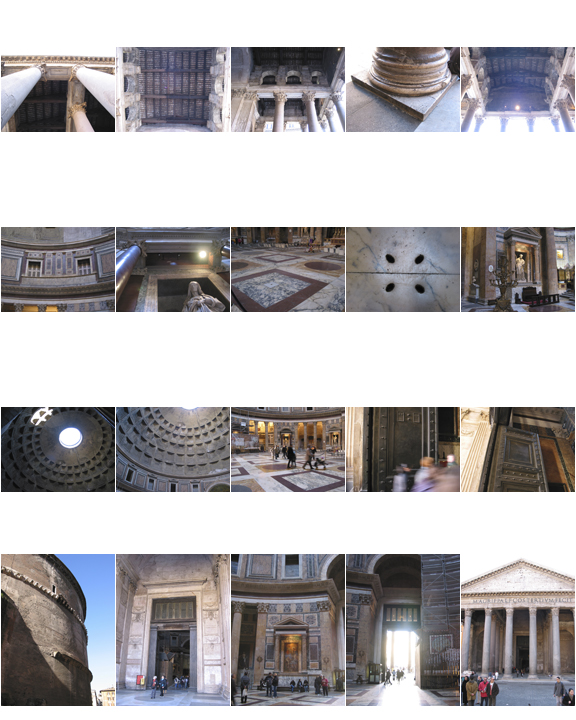
photos by Mark Cichy
Joshua
Bedard:
Upon viewing Peter Greenaway’s The Belly of
an Architect, one can quickly see the use of symmetry in numerous scenes
throughout the film. Before I comment and speculate on the use of symmetry
in the film I would like to point out that I have never been to Rome.
Therefore my view is strictly bias through the eyes of Peter Greenaway.
In Greenaway’s film the viewer is constantly confronted with numerous
symmetrical frames. This starts within the film immediately. Right at
the beginning we see a shot that focuses in on a street symmetrically
framed by two classical Roman buildings. Then in the centre we see the
title of the film appear. This is how most of the symmetrical shots within
the film are constructed. They usually consist of a framed view with a
left side that very closely mirrors the right side. These masses help
create a focal point that ultimately provide a sense of place within the
film. In most of these symmetrical shots Greenaway heavily relies upon
the symmetrical order of classical architecture and monuments to establish
the focal point. This focal point becomes a very powerful spot in which
we commonly observe the main character, Stourley Kracklite, an egotistical
architect.
Just as
Greenaway takes us into the life of his main character he also intrigues
us into the city of Rome. Through the use of symmetry he begins to create
a parallel of power between the main character and the city. We begin
to see the quest for power and order throughout the film. We start to
believe that Rome is all about its historical and pristine classical architecture.
We start to believe that these buildings make Rome what it is. We begin
to see the power these buildings posses. However, as the main character
begins fall sick we also start to see more modern buildings. Unlike the
classical buildings these modern buildings (some of which I know very
little of) leave me with no connection to the city of Rome. Unlike the
classical buildings, these non-symmetrical buildings do not posses the
same sense of power. In this sense the lack of symmetry helps depicts
Kracklite’s decline in power.
In conclusion,
Greenaway uses symmetry to place myself within the Rome that I am familiar
with. This is the Rome we most commonly identify through architectural
history books. Again and again these books show the power, order and focal
points created by classical architecture. However, I feel ignorant and
less connected to present day Rome. For this reason when the symmetrical
frames and buildings begin to dwindle and we see more modern artefacts,
I begin to feel more distant and ignorant of present day Rome.
|
|
| x |
3. Gibson,
Nancy
+ Bolen, Matthew -- foreshadowing
coupled with "bookending" |
x |
| |
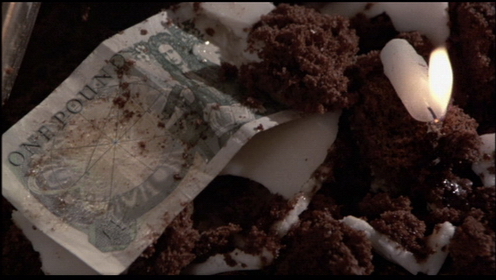
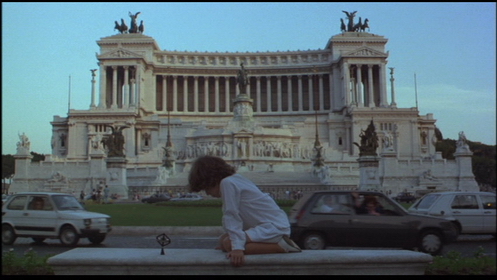
Nancy
Gibson: Foreshadowing coupled with Book-ending
The movie
begins with the Pantheon looming in the background of a dinner during
which, the project of Stourley Kracklite, an unknown, contemporary architect,
is introduced.. The image of the pound note, lost in the dome cake and
burned by the candles, foreshadows financial ruin and the disease of the
architects stomach. This setting is repeated at the impending death of
Kracklite and the loss of his project to the Italian rival. In the alternate
scene, Kracklites stomach cancer has been established and he is no longer
in control of the exhibition. The pantheon looms in the background as
permanent as ever suggesting the insignificance of modern man against
the massive legacy of the past. The massive architecture of the Vittorio
Emmanuel monument punctuates the film, dividing it into episodes. It divides
his experience in Rome into small bites of his life as it deteriorates
around him. He feels he’s being poisoned. He suspects he’s
dying but the doctors are dismissive. He begins to write postcards to
a dead architect. The project is removed from his control and finally
he kills himself. The Vittorio Emmanuel monument remains eternal (at least
until the film rots).
Matt Bolen:
The two images
provided are clear examples of how both foreshadowing and book ending
are used in this film.
The British pound with the image of Sir Isaac Newton being burned symbolically
foreshadowed the destruction of Kracklite’s connection to Boullee
and the exhibition which he had devoted his life to. This was a symbolic
foreshadowing because Kracklite’s connection and admiration for
Boulee was similar to a connection Boulee had for Newton during his lifetime.
The last scene of this film is the view of the classic Roman building,
which was used for the exhibition, with the boy spinning the toy that
Kracklite had given him. This image can be viewed as a moment of book
ending in a very literal sense. This scene was foreshadowed earlier in
the film when Kracklite and the boy met outside Kracklite’s apartment.
From the viewpoint of someone who has never been to Rome, this last scene/
shot could be viewed as a commentary on the architectural permanences
that exist throughout Rome and how they can exist and thrive throughout
many lifetimes. One could argue that this scene could be seen not only
as the ending of Kracklite’s story with his death but also the beginning
of the story of the boy. The story of the boy could be imagined as following
a very different path, however, the identical Roman architectural backdrop
could be used just as effectively thus emphasizing its permanent and versatile
quality.
|
|
| |
4. Olivia
Keung
+ Brown, Liam -- symmetry combined
with use of colour |
|
| |
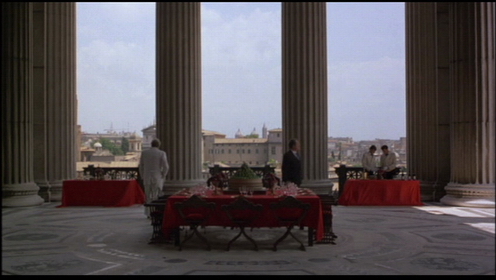
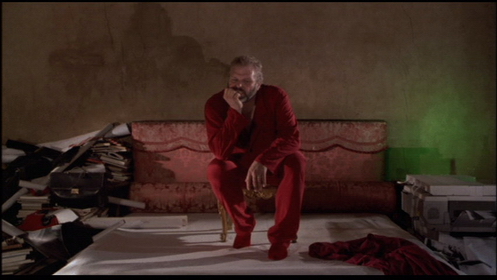
Olivia
Keung
The role
of symmetry in the film serves a purpose that is directly linked to that
of the colour white: both elements present Kracklite’s early vision
of Rome, a place of stability and eternal, unchanging history. It is the
textbook version of a city where architecture can measure man’s
exact position in the universe. Kracklite begins the film certain of his
own position: he enters Italy as a celebrated architect with a beautiful
wife; his confidence gives him the ability to believe in the geometric
perfection of Étienne-Louis Boulée’s architecture,
although most of it was never even realized. Kracklite is able to work
on his exhibition for ten years without questioning its relevance in the
modern world.
Having been
in Rome will perhaps give the viewer the advantage of understanding the
flaws of this vision more blatantly. Through the experience, one realizes
that when such an idealized vision, such as the Pantheon, becomes realized
as architecture, its existence exposes it to the imperfections and chaos
of reality. In truth, the Pantheon is riddled with bullet holes and other
signs of decay; even the vision it carries has been marred by its conversion
into a Christian temple. It is also surrounded by cafés and banks,
signs of change and newer visions such as the arches of McDonald’s
that faces the monument audaciously: all of these things have been edited
out by Kracklite’s stubborn vision. Similarly, the balanced view
of the clean, white monument of Vittorio Emanuele is, in reality, something
that can only be attained from across the chaos of traffic and tourism
in Piazza Venezia.
It is appropriate
that Kracklite’s idealism begins to deteriorate at Hadrian’s
villa, a place where the emperor celebrates the world for its variety
instead. The injection of colour also shows the invasion of elements that
threaten Kracklite’s solid beliefs. Kracklite in his bright red
pyjamas reveals himself as a foreign agent, ridiculed by his Italian peers
who do not hold Boullée in the same regard. Flavia’s red
couch is the place where Kracklite cheats on his wife, amidst the black
and white photographs on the wall that are posed and frozen. Kracklite’s
eventual downfall is metaphorically reflected in the chaos that he eventually
comes to see in Rome, a city that Boullée never travelled to or
learned to understand.
Liam Brown
Throughout
the film the majority of framed views or vignettes that pose symmetry
are of a positive and negative arrangement: specifically black and white.
Where white may represent the purity of Rome, in its calculated form and
structure, the black is often in the shadows, helping to create a bold
contrast or silhouette often between Kracklite and his setting. Accented
red later builds these framed shots and add to their significance. In
the
case of Kracklite, he exists in the shadow of Étienne-Louis Boulée,
his own character and identity are masked in the figure of Boulée.
He superimposes himself somewhere where he does not belong. Physically,
this is true for the buildings of Rome, but figuratively
this is true when he adorns his abdomen with the body shapes of Augustus.
As Kracklite falls apart so too does our image of Rome as an unvisited
place. Caspazian’s sister throughout the film has been observing
him through pictures and as his life falls apart he is confronted with
her created timeline, a collage of his time in Rome, that is displayed
in a horizontal arrangement, guided by a curving red ribbon. He sees shots
of symmetry arranged in a jagged non-symmetrical order, illustrating the
chaos of
the seemingly symmetrical Rome. Following this he continues into a new
irregularity.
He breaks his remaining sanctity of his marriage on a deep red couch,
with Caspazian’s sister. After this encounter, Caspazian remarks
that “Boulée knew more about colour than Leonardo Da Vinci”,
a statement that Kracklite was not aware of (and Kracklite does not hear
the remark). In the following frame Kracklite is poised on his bed, overlooking
the threshold between himself and many images of the muscular chest of
Augustus. Beyond the pictures is a mirror, where the image of himself
is reflected back at him completing a new kind of symmetry. He is set
against Rome, seeing himself as an alien, but still engaged with his icon.
Colour plays an important role here, as his clothes are rich and lush
with red. He is troubled about his health and his image as well as money
for the exhibition. He scorns his wife for exposing her pregnant body,
but he himself has been photographed without his shirt, bloated with a
different kind of growth. He has been changed by Rome, but Rome has not
been changed by him, as the film ends it recants aprevious setting when
he was standing symmetrically in the Pantheon about to give an address
of his intentions, instead he falls backwards through the very same opening
he posed in front of before, killing himself. Throughout his madness,
there is a departure from the symmetry of Rome, but in the end it shows
that although he had changed, Rome had not, its symmetry continued where
his finished.
|
|
| |
5. Julia
Farkas
+ Chau, Tammy -- bellies... |
|
| |
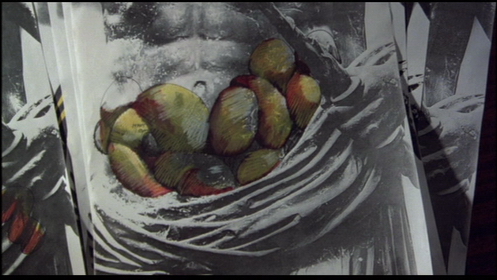
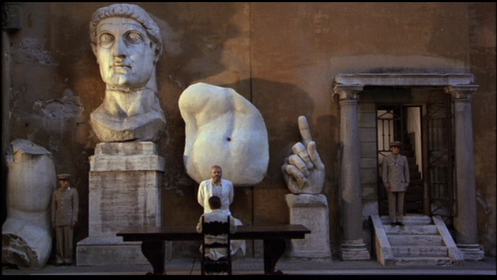
Julia
Farkas:
Greenaway
uses the image of the belly numerous times throughout the movie to explore
the source and sustenance of our humanity. The movie repeatedly narrates
back and forth between the corporeal bellies of Kracklite, his wife and
his idol - Etienne Boullee, and those of urban morphology- the void of
the piazza, the dome of the Pantheon, the tomb of Augustus….. They
all resemble the expanding space of our insides as they swell with the
sound of a huge mass or dwindle to the silence of a single inhabitant.
The film, however, always keeps us outside of these architectonic spaces,
marveling at their beauty from without, just as Kracklite obsesses over
the untouchable intestines of Boullee. The connotation of the belly here
conceivably deals with the theme of lineage. His obsession with Boullee’s
belly is perhaps a vain attempt to seek the patronage of his beloved mentor,
in effect to begin to understand the character behind the image.
Furthermore,
the belly acts as the source of life and death in the film. Likewise,
the bellies of Rome are the scenes of life and death in the city; the
piazza, the church, the spaces of congregation are the sites of urban
existence.
The space
of the film follows Kracklites’ child from conception to birth while
watching him suffer death, perhaps a necessary course of events in order
to bring life to his creation. The theme of sustenance returns here once
again. The belly an organ that is suppose to be the source of his nourishment
however, is what in the end consumes him.
|
|
| |
6. Adriana
De Angelis
+ Czypyha, Shane -- framing
as manipulation |
|
| |
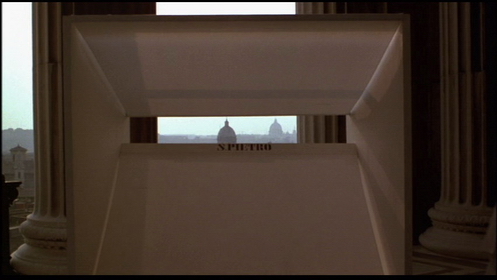
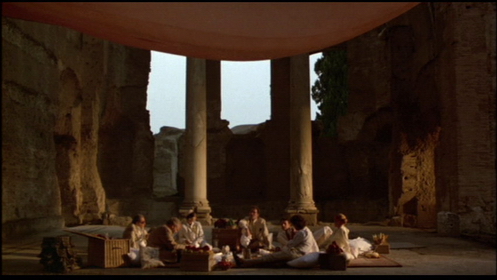
Adriana
De Angelis --
Framing as manipulation
Peter Geenway
came to Rome in a difficult moment of his life, while undergoing a severe
nervous break-down; his film, The belly of an Architct, was directed right
after. It is notorious that the vision of anything when suffering, expecially
when cancer, depression or obsession occur, is completely different from
the one any person would have in moments of perfect health. When ill,
sickness becomes the frame of anybody’s life that results manipulated
and focused only on peculiar topics, in a distort, haunting and maniac
way. Illeness it’s definitely like watchig the whole world through
a telescope and that’s exactly the way Greenway wants us to look
at his film and at the city of Rome, forcing us to concentrate our interest
only on his vision of things. The empty, iconographic, magnificent, actually
nonexistent Rome that interests him is the one of the two moments of its
splendour and decadence where the leading character is completely alone
with himself: the Imperial/pagan and the Baroque/catholic. Two focal moments
that reflect the splendour and decadence of an architect, Kraklite, and
of a film director, Peter Greenway. Everything and everybody, even Hadrian
and August, Boullée and Newton, around the protagonist architect
(isn’t a film director sort of an architect too?) reflects his feelings,
his fears, his thoughts, his life. The film is a continous demonstration
of how Greenway skilfully handles Rome, its inhabitants, actors and public
through his story. Emblematic of what we are trying to say are two particular
takes: the first at the beginning and the second at the end of the film.
In fact, the modern pic-nic held by all the charcters in one of the few
remaining buildings of Villa Adriana, because of the particular frame,
it’s magically transformed by Greenway into one of this almost indecent
banquets of the Imperial Rome where everything is sick, particularly people
that participate. At the same way, probably knowing the idea that was
already of Le Corbusier, using an artificial fabric camera set between
two columns of the huge Vittoriano’s balcony, excluding all the
buildings and domes of the breathtaking view, Greenway artfully directs
our regards on the only two he is interested in: Saint Peter and Sant’Agnese
in Agone. Is this his way to indicate a desire of rebirth to a new, more
spiritual, healthier and just way of life?
What is your
impresson of the conflict in the film as it relates to the representation
of the Italians and their relationship with the Americans?
Stereotype
it’s just another form of illness, exactly like cancer, depression
and obsession. It’s a frame that manipulates people’s thiking.
While as an illness I consider it indispensable for the story Greenway
is telling us, it’s to me absolutely incomprehensible in any day
life from which should be banned. I think the world is sufficiently adult
and with no barriers anymore to start looking at people as individuals
and not as representatives of different nations, admitting that we’re
all the same, with the same fears, the same thoughts, the same dreams,
the same faults, the same souls.
Shane
Czypyha:
The city
of Rome, as presented in Peter Greenaway’s “Belly of an Architect,”
is framed as a place dominated by singular elements and focuses set into
a consistent homogenous fabric. Greenaway manipulates shots so that the
cinematography reveals only a fraction of the place and the stories that
accompany. The focus is left on the main character, Sturley Kracklite’s
story.
The hazy view through the small slit reveals an undefined mass. The domed
cathedral, the only building in this view with any definition, rises above
the mass taking the entire focus of the shot. At Hadrian’s villa
much of the shots employed focus only on where the picnic is and hardly
at all on the architecture of the entire space. At the Pantheon the shots
are almost all directed at the fountain, or at the dinner tables in front
of the building. In most of the shots at the place of the exhibition the
view is dominated by the grand exterior staircase. All of these are examples
of how the overall city is neglected in favour of a more focused narrative.
Flat scenes, like photographs or paintings, articulate setting and scenario,
while the articulation of the humanistic side of the film is left to dialogue
as well as placement and positioning of people in the flat scenes.
The shots of the city, which allow focused and fragmented glimpses of
the entire setting, closely parallel Kracklite’s focus on his time
and purpose in Rome. He only sees things selectively, in a way completely
ignoring things integral to his success and happiness. He only sees Boullee,
a theoretical and largely unproven architect, in Rome, the richest architectural
setting in the world. He thinks his wife is poisoning him rather than
the cause of his illness being due to other factors. He sees Caspasian
stealing his exhibition and neglects the fact that he is stealing his
wife.
The framed views are meant to provide a window for Kracklite’s dillusion
that leads to his demise.
|
|
| |
7. Francesco
Mancini
+ Drago, Natalie -- architectural
enclosure combined with "framing" and continuity |
|
| |
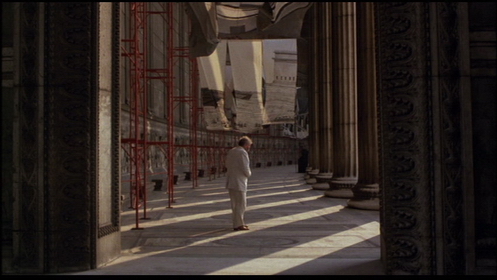 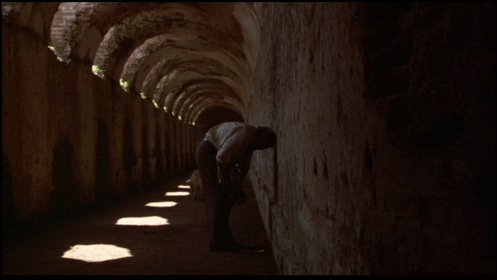
Francesco
Mancini
Rome:
Seven Postcards and a bill
Pantheon,
late night
Dear Etienne Louis, I am so happy. Here at last, in the eternal city to
celebrate you, before Pantheon’s immensity, tasting life at its
roots, I do not see nothing but you standing in front of me, as an immense
obelisc. I am not tired of eating so much, not tired of pursuing the effort
of an entire life. I know that this spherical enclosure of perfection,
symbol of perfect and insuperable science, is protecting me.
St. Cracklite, Architect
Vittoriano,
afternoon
Dear Etienne Louis, life seems different today. Last night I saw the perfect
symbol for the exhibition opening: your Newton memorial, strangely but
beautyfully broken in two pieces. Today, except for my wife’s dress
everything was pefect: simmetry, axiality, colour, light, even people.
Looking at them I cannot see nothing but the perfect balance of spirit
and reason pervading your achitecture, pervading me.
St. Cracklite, Architect
Mausoleo
di Augusto, morning
Etienne, today I am furious. This beautiful monument is closed, framed
by gates and chains; i cannot stand this excess of enclosure, of preservation:
this is breaking the continuity of my research. Instead of visiting this
marvellous tomb I will go to the museum..... I did not sleep good these
days. May be the pears, those awful green pears....
Villa
Adriana, late evening
Dear Etienne, I tried to find back my spirit today, having dinner with
my wife, but I couldn’t. I threw out many times these days. It was
painful, as if I was pregnant. I felt spied in the bathroom, are you watching
me? Today I felt safe here, but then in the corridor I had another crisis.
Carcinoma, poisnoning..... what’s happening to me Louis? In the
teatro marittimo I felt somebody’s presence outside, taking slides
of life away from me, still by still leaving me alone. Talk to me Louis....
Stuart
San Pietro,
late afternoon
Luis, today I looked at the doome, it is no longer in the center; out
of focus from the obelisc, the great city belly is still dominating the
void of the Piazza, lightened by a marvellous sunset, but remembering
me the drama of Borromini’s doom and piazza Navona. Axes and shapes
are moving before my eyes, but why do I see only rough greeny copies of
the original? My ambitions and passions are still alive, but what about
my future? It looks like an agony.
My wife is pregnant, did i tell you that? I need more space for the exibithion.
Stuart
Fori
imperiali, evening
My wife betrayed me. I am lost, life has no longer any color, taste or
value to my eyes. I look for you, and I see Piranesi’s ruins thrown
out of Rome’s stomach. Everything I thought to be safely enclosed
in the world’ s perfect frame is now broken into my life fragments.
I alwas climb stairs, but to go where? This cancer is devouring me.
Palazzo
del Lavoro, noon
I would like you to be here today looking outside her window: What a fake
building out there! They claimed they were inspired by your values, Etienne,
but look at those arces: they frame nothing; a concrete structure uphold
them. Now I am in her room looking inside: all this pictures about me,
Kaspar and Julia ... How could I be that blind? Life is obsessed by our
way of framing reality. Despite our passions we try to section it in a
scientific way, to find its true one meaning, but life is not about that.
Passion cannot be enclosed by perfection, it changes: through her eyes
I see a different world. Louis, did you ever speak about love?
The Bill
Dear Etienne your effimeral exibition is starting, my life is ending.
The spherical journey of my life is almost completed now, except for a
last excess: one step back, to my untouchable memories of perfection,
closing my eyes to finally catch the life I pursued and that never was.
See you soon
Stourley
Kracklite
Architect
Natalie
Drago: Architectural enclosure combined with framing and continuity.
In both scenes
the architecture is the physical element that encloses, while Stourely
becomes the enclosed object and the framed subject. His mental state in
each case is altered or affected by being enclosed although the qualities
of the two enclosures are in comparison and contrast with eachother. Enclosed
space alludes to framing by nature of its own physical framework.
By means
of his body language we are able to determine the weight of the enclosures
he subjected to. In the arched hallway the atmosphere is dark heavy and
overbearing and speckled with small traces of light. There he bends and
is ill. It is as though he is responding in a guttural fashion to the
negative aura and feel of the space as well as portraying the illness
that inflicts him. Singling this shot out we may even analyze that his
actions demonstrate his physical and mental condition, the mental condition
affects by the space he occupies in which he is oppressed and enclosed.
In the lighter,
airier corridor enclosure, flanked by tall sturdy concrete columns, Stourely
again remains subject to his condition in terms of his physical setting
and physical ailments. More light penetrates this semi-enclosed space
and overall it feels lighter and less imposing. This space is less oppressive
than the previously mentioned. Although he is still sick we see that here
he stands erect and can deduce that his physical environment has greater
influence, power and meaning beyond that of just setting in this plot.
Still his eyes are downcast as previously, reiterating his condition and
mental state and the fall out of the plot and his character.
These scenes are related and connected by means of the camera work. The
camera provides the opportunity to frame any event. It decided what is
included and excluded within a capture, what is of interest, valuable
or of importance, enabling the directors to convey the message tone and
mood in a scene. The frame of the camera then dictates boundaries, outlines
context and emphasizes forms and gestures.
Scenes are
constructed by fitting and uniting smaller parts of a larger structure
similar to the bones of the human skeleton. In each shot Stourely’s
posture resulting form reflects and defines the structural principals
of the corridors, whether arched or erect in nature. Form always eluding
the physical properties either found in nature or the human body. The
exposed structure, the skeleton, the body, death and decay.
Hence the
framework is based on the principal of a frame within a frame. Delivering
a sense of perspective, an outlook, an understanding, an analogy, a response
and sense of enclosure. All these responses to setting are inherent to
the human psyche’s abilities, visual, sensorial and temporal analysis
of distances, proportions, materiality, weight and lightness and darkness.
Each photo of each enclosure is transitive, characterized by having or
containing a direct object. It is also transitive because the object is
“being or relating to a relation with property that if the relation
holds between first and second and between second and third, it holds
between the first and third elements”, the unfolding and mathematical
relation and rationale of events. Architecturally there is a progression
that is related to or characterized by transition or movement through
and about the spaces. While enhanced and reinforced by setting.
The progression
through the space is accompanied by a succession of columns in each photo
strengthening the aspect of continuity in the film and the architecture.
There is an uninterrupted connection between subject, enclosure, event
and plot in each shot. There is also an uninterrupted connection between
the regulated rhythms of the arches and the regulated rhythm of the body
as he vomits. The regulated sound ‘thud’ by the tall open
columns in the rectilinear corridor an they reach the ground and the thud
of Stourely’s body when he hits the car roof.
The roof
structures above his head, weather rounded or flat join the corridors
to the larger buildings and the setting link the events to a bigger picture.
Th seeming endlessness of the corridors, the seeming endlessness of Stourely’s
obsession with stomachs, all events and spaces or setting melding to form
unity.
Therefor
continuity in the architecture has been achieved through rhythm, succession
of columns and spaces, design, materiality and style. While the scripts
or scenarios, story, or dialogue are unified through acts, postures, costumes,
style and demeanors demonstrating continuity in the plot. The architecture
and themes and moments in the film work hand in hand indetermanently and
continuously. Themes persist architecturally and thematically, form unions,
rereveal themselves and reoccur throughout an uninterrupted duration,
without any essential change, strengthening the aspect of continuity within
the film by means of setting or plot. The element of architectural combined
with framing and continuity defines shapes the film, while developing
and unfolding along side Stourely enhancing and describing the trials
and tribulations of his battle with cancer and failed interpersonal relationships.
In themselves, these elements define and describe an era of architecture,
an outlook and philosophy prevalent in the past and present Roman culture
appropriately adopted for an art film of this nature, characterized by
its brutality and exploration into the darker realm of social dynamics,
interpersonal relationships and obsession.
|
|
| |
8. Christian
Tognela
+ Krejcik, Andrea -- use of
colour and photographic images |
|
| |

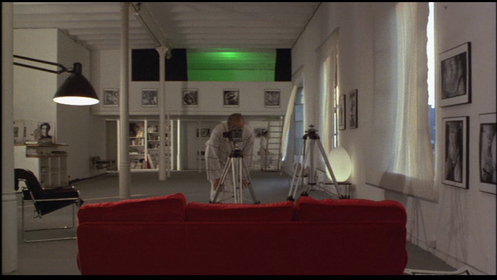
Christian
Tognela -- A Walk Through...The Belly of an Architect
| B
is for BLACK |
All
the people at the opening of the exhibition are dressed in black,
all but Kracklite’s wife who is in white. All people wear black
suits as if they were at a funeral, and in that moment Kracklite jumps
off the window and falls dead on the car roof. At the same time the
baby is born. In many frames we can see Kracklite in black and his
wife in white...in their belly they are carrying death and life. |
C
is for COLOURS |
They
play a big role, those which appear in every single frame and those
which don’t appear at all. Greenaway used to talk about himself
as a painter who uses film instead of a paintbrush. Red, green, blue,
white and black: everything seems to turn around these pure entities.
F is for FILM Kracklite discovers photos on a wall. Photos of him
while he was not supposed to be portrayed. His life was on these films.
Frames by frames photos seems to reveal what Kracklite could not see. |
G
is for GREEN |
The
colour of evil, the colour that Boullèe hated. The First time
Kracklite feels sick just after having eating green pears; when he
suspects he’s been poisoned by his wife, he’s eating green
figs; Caspasian’s car where he falls onto when he kills himself
jumping off the window is green; light of the copier when he starts
being obsessed by images is green |
K
is for KRACKLITE |
About
colours...could it be possible to split Kracklite into 2 parts? Krack
is to crack...and lite is light..in other words...to break light,
divide light into all its components, analyzing its spectrum and then
choosing the colours...that is what he does. |
P
is for POSTCARDS |
Again
pictures, postcards, photos of momuments. Kracklite writes to Boullèe
about something he cannot handle very well. Can they reveal the truth
to him? |
R
is for RED |
It’
is THE colour. Clothes are red, Kracklite’s clothes are almost
red, when he is at the Pantheon for the first dinner; while watching
copies of belly; everything at the exhibition is written in red; the
ribbon which seems to connect the photos and the life of Kracklite
is red; the main colours of Kracklite’s house is red; the sofa
where he has sex with Flavia is red; red is the chair where he watches
his wife betraying him...all pivotal moments pass through red. |
W
is for WHITE |
The
colour of Boullée’s architecture. The colour of the monument
of the Unknown Soldier in Rome where they want to organize the exhibition. |
X
is for XEROX |
Images
that become obsessions; by the copier it seems that this obsession
increases in intensity, the more he gets copies the more he feels
bad. And on these copies he tries to see his pain. |
Y
is for YANKEES |
The relationships between Kracklite ( the American) and the promoters
of the exhibition ( the Italians) are conflictual. When Caspasian
is asked what he thinks Kracklite is thinking, he answers he’s
American and cannot think. All relationships are wicked, each time
there is some kind of contact it is for money or for blurred issues.
Greenaway as usual is much more interested in the most twisted aspects
of life...what we see is a very greenaway baroque way of describing
things...
|
Andrea
Krejcik: Question: Colour and photography in Belly of an Architect. Using
these aspects in the film, describe your experience of Rome based on the
fact that you have never been there?
Set in Rome,
the movie, Belly of an Architect, is a film showcasing the beauty of Rome
in very distinct and purposeful ways. Colour is used greatly in order
to convey a message to the viewer. It not only enhances and brings contrast
to the scenic images laid throughout the film, but it also sharpens the
main points of the plot. Photography is another medium used with significance
throughout Belly of an Architect to provoke and capture ideas within the
viewer’s eyes.
The prominent colours and shades used throughout the film are red, green,
white, and black. They appear in scenes signifying important moments or
characteristics. Red is most obviously noticed. The colour red has a meaning
of passion, love, warmth and intensity. It also brings an image of blood
or sickness. Stourley Kracklite is seen in many scenes wearing red or
being very near to red objects. Stourley, is an architect who is very
passionate about his work on Etienne-Louis Boullee. However, tragically
he becomes ill which is the cause of his downfall and the loss of his
work. The colour red accentuates his passion during scenes, or identifies
the demise of something close to him. His wife wears red at an opening
function, and later in the film she decides to cheat on Stourley, hence
leaving him for another man. Stourley wears a red tie when explaining
his work, and later his work is taken away from him. This is seen again
as red scaffolding during the construction of his exhibit which will later
be taken away from him. Red is used to show Stouley’s progressing
physical and mental sickness as well. Stouley believes his stomach pains
are brought on by his wife poisoning him. At night when he accuses her,
she is wearing a red night gown. Or the table where Stourley and his companions
sit for lunch is draped with a red table cloth. Again he thinks that someone
is trying to poison him.
Green is a colour more of hope, freshness and nature. In the movie it
is usually shown coming from an unnatural source, which may indicate that
Rome is an older city which must import from other places in order to
bring things of new into the city.
One could argue that being outside, one is still standing inside a structure
in Rome for ruins lay everywhere. The movie indicates such a feeling by
the immense use of whites, greys and blacks. A lot of the scenery is either
concrete or stone and hence takes on a grey hue. This could also mean
however that Rome is pure, which is represented in its white shades. A
colour brought into the city is brought in by foreigners inhabiting Rome.
Therefore green and red are able to stand out so much in the film.
Photography in Belly of an Architect is always shown as black and white.
Black and white can capture the purest of objects. Since Rome and occasionally
Stourley is seen as pure (when he wears white suits during meetings with
exhibit endorsers), colour is seen only when an exterior force is brought
in. On the black and white pictures of a statue’s stomach, colour
is added to the complete or perfect picture only when Stourley tries to
identify his illness. Red is shown as well in the scaffolding which signifies
an alien object for a pure and functioning structure.
The image of Rome using colour and photographic luminaries is one of distinction
through age, and one of purity. Colour along with photography help to
separate, contrast and isolate major artifacts in the city along with
major points in the film.
|
|
| |
9. Federica
Martella
+ Liu, Vivien -- symbolism |
|
| |
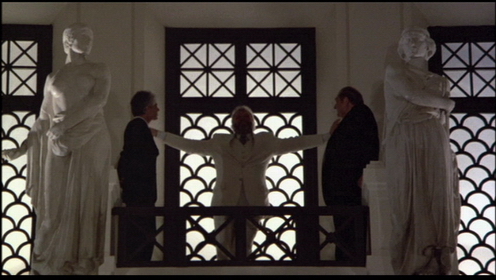
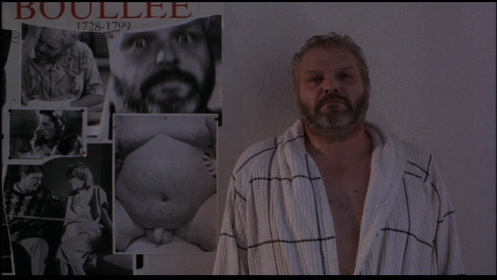
Federica
Martella
“The
Belly of An Architect” includes themes as aesthetics of Art and
Architecture, the limits and possibilities of mortality and immortality,
and the influence of obsession and omens. As in all of Greenaway's films,
symbolism, parallelism, allegory, and striking but static visual compositions
are the order of the day.
Many of these symbolic elements are evident in the structure of the film.
First of all it is based on two specific numbers: 7 and 9. The first is
an important number for Rome: it represents the hills of the city, the
kings, the historical periods of the roman architecture. Seven are then
the architectures in Rome that would have impressed Étienne Louis
Boullée's work:
Augustus’s Mausoleum, Pantheon, Colosseum, Villa Adriana, San Peter’s
Basilica, Foro Romano, Piazza Navona and the 'square Colosseum', Palazzo
della Civiltà del Lavoro. Seven are also the postcards that Kracklite
writes to his architect Étienne Louis Boullée.
Number 9 matches instead with the months necessary for preparing the exhibition
on Boullée’s work; with the length of Kracklite’s wife’s
pregnancy, from the conceiving at the beginning of the movie to the born
of Kracklite’s son at the end of it. The movie was made in nine
months as well.
The first
image selected from the film shows Kracklite standing at the top of the
stairs inside the Vittoriano, the monument of Victor Emanuel.
He wears a white suit, creating a contrast with the other characters (white/red,
white/black are the predominant colours contrasts); the symmetry of the
image is evident and he will assume the same Christ-like posture when
he will end his life by falling backwards through the same window, in
the same place, during the opening of his Boullée project. Furthermore,
it is in this moment of the plot when the two Italian men standing beside
him tell him that the architect of the Vittoriano, Sacconi, suicides himself.
This first sequence shows the greatness of roman architecture, underlined
by the Greenaway's outtakes that present a Rome never seen before, frozen
in its eternal beauty and opposed to Kracklite's decline due to his illness.
Then it is inside this place that Kracklite's illness, the pregnancy of
Louisa and the planning for Étienne Louis Boullée's exhibition
end at the same moment: Kracklite dies, Louisa gives birth to her child
and the exhibition is inaugurated.
The pictures on the wall, shown in the second selected sequence of the
film, let Kracklite become aware of what is happening around him and he
understands the weakness and the failure of his life.
“Like
the contours of the body of an organism, whose genetic resources include
the limits within which his growth will be contained, so in the elements
that constitute the structure of the culture are included the limits of
its ‘wholeness’. Every architectural structure has the tendency
to ‘grow’ up till becoming a whole” (J. Lotman, 1998).
Vivien Liu
Greenaway,
in his “The Belly of an Architect”, focuses less on storyline
but rather emphasizes the poetic qualities of Rome’s splendid architecture.
As a viewer who has not experienced in real life the grandeur of Rome’s
architectural treasures, the film provides a poignant introduction through
not only the use of visual communication but also through a mesmerizing
musical score. The major spaces of the Vittoriano have especially been
familiarized to the viewers as many scenes take place within the same
spaces in the building, both in the interior and on the exterior. This
signifies the eternal existence of Rome’s architecture – the
events within them are ephemeral, while the form retains its splendor
and remains constant.
The first
image depicts Kracklite standing in a posture reminiscent of Christ in
front of a window in the Vittoriano – it bears a symbolic meaning
of a heroic death. This becomes clear at the end of the film when the
scene is repeated as Kracklite ends his life by falling through the window
in the same posture. At the same time, his exhibition dedicated to his
hero Boullee is completed, and his wife gives birth to his child. Kracklite’s
white outfit contrasts with the black suits of other men, and creates
a sense of holiness together with his Christ-like posture.
The second
image is when Kracklite discovers the secret documentary of photographs
taken by Flavia, and places himself at the end as part of the sequence.
The series of photographs document the nine months during Kracklite’s
stay in Rome, recalling some painful moments of his failure. He stands
helplessly at the end of the sequence juxtaposed with a picture of his
belly, signifying his obsession and the cause of his downfall.
Boullee’s
dome that was first introduced in the form of a cake at the beginning
of the film is symbolic of Kracklite’s obsession with the oval,
reflecting his obsession with his belly, the pregnancy of his wife, and
Boullee himself, who also suffered a stomach illness. |
|
| |
10. Arvai,
James
How would this film have to be refigured if it were
set in Paris (if you are not familiar with Paris, pick
another urban city other than those already assigned, preferably one with
a rich historic architectural heritage -- but the question will really
not work as well if you don't pick Paris...)? What architectural elements
would you substitute? How would it potentially impact the plot -- ie.
the theme of Boullee?
|
|
| |
In the symbol
rich film “The Belly of an Architect” the artifactual histrionic
architecture of Rome plays a central role. Various monuments of the Roman
Empire are displayed as static symmetrical images for some 10 to 20 seconds
as a powerful visual metaphor for Rome’s endurance and scale. It is
a counterpoint to the limited time-scale of the individual. The individual
architect, Kracklite, with his obsessions, suspicions, delusions, and paranoia
faces the truth of his incomplete life and pending death against the backdrop
of the constancy of Rome’s monuments.
In Paris,
as in Rome, Kracklite would be the ineffectual foreigner floundering in
a strong traditional closed culture.
If the film
were to be transplanted to Paris, architectural monuments would have to
be selected that maintained the same metaphorical relationship of enduring
monument to fragile man. The monuments would have to speak to the apex
of French classicism, when Paris was the center of western civilization,
the 19th century.
The welcoming
dinner scene set in the piazza in front of the Pantheon could be reset
with diner in the park in front of the Eiffel Tower – a monument
of permanence built in 1889 commemorating the centenary of the French
Revolution, a pivotal moment in the 18th century. Kracklite could be shown
visiting Napoleons Tomb as a substitute to Augustas’s mausoleum.
The Piazza Navone could be replaced by the Champs D’elysee. The
Palace of Versailles as the Baroque monument of France could be substituted
for the Coliseum and Hadrian’s Villa. The exhibition venue location
at the monument to Victor Emmanuel II could be substituted with the Louvre
as the architectural monument to French cultural achievements.
The theme
of Boullee as a clever transcending image could stay intact in this Parisian
setting. Boullee’s fifteen minutes of fame for the belly-like spherical
Cenotaph for Isaac Newton is juxtaposed against the belly of the architect.
Boullee, who’s Cenotaph was never built, seems a perfect fit to
Kracklite’s incomplete life and inability to control events in his
life. Kracklite also wonders if Boullee, an outsider, was caught up in
the futility of a foreigner finding himself swept under in a culture of
tradition that is stronger than the strengths of an individual.
Kracklite,
in Paris, could have obsessed on Boullee, French Kings and Baroque landmarks.
Kracklite
could have self-destructed in Paris as well as in Rome.
|
|
| |
11. Nelson,
Aaron
How would this film have to be refigured if it were
set in Dublin? What architectural elements would you
substitute? How would it potentially impact the plot -- ie. the theme
of Boullee? |
|
| |
Keeping
the theme of Boulee and refiguring and placing the movie The Belly of an
Architect in Belfast, leaves and creates many cultural impacts on the story
line while preserving the original plot. The story would read as such:
The movie would open with the couple making their way on train from southern
Ireland to Northern Ireland, The opening dinner party to celebrate the exhibition
of Boullee would be in the gardens in front of Belfast castle situated on
the slopes of Cave Hill over looking the city and the Lough. The exhibition
will be held in the Ulster museum. Stourley would become obsessed with the
troubles and with southern Ireland, which is fueled by his stomach pains
and desire to become involved. His paranoid lack of interest in his wife
leads to her affair with a charming young Irish architect, bringing pregnancy.
Stourley further obsession of the troubles brings self portraits and photographs
of himself in Republican solder attire, constantly focusing on his stomach.
His obsession leads to him loosing the contract to direct the Exhibition
at the Ulster museum due to his political connections. Instead of walking
through the roman busts Stourley will be driven in an RUC land rover through
and around the dangerous areas of Belfast being shown how supporters have
met their end, and a warning to leave the country or you might meet the
same ends. The ending of the exhibition shows his wife pregnant cutting
the ribbon alone. Stourlely lies dead outside the museum after being shot
due to his involvement in the troubles.
The scenes of him eating an orange in the roman ruins would be replaced
with an apple, walking through the glens of Antrim, and swimming in the
Lough, and the first meeting of his wife's adulterer would take place at
the neo-Romanesque architecture of St. Anne's Cathedral. |
|
| |
12. Myers,
Elizabeth
How would this film have to be refigured if it were
set in New York (if you are not familiar with New York,
pick another urban city other than those already assigned)? What architectural
elements would you substitute? How would it potentially impact the plot
-- ie. the theme of Boullee?
|
|
| |
The Belly
of an Architect is a beautiful film, full of the sites, sounds and experience
of Rome. To imagine it taking place in New York instead would be to completely
change the film. Unlike many films that could be set anywhere, The Belly
of an Architect is as much about Rome as it is about the plot itself.
Setting wise,
the many picturesque shots of picnicking out of doors by the base of a
monument or over looking the number of notable buildings would most likely
be eliminated. To dine in New York means to experience one of the many
wonderful restaurants. It is about the interior, the small scale, the
chef and the décor. There are few places where one would want to
picnic on the streets of Manhattan. This would mean that the intimate
feeling of the film would be loss. Instead of private gatherings in quiet
places, they would be meeting in busy restaurants or bars, surrounded
by other activities and conversations. The sounds of the film would change
from the peace of church bells to traffic, sirens and the constant murmuring
of other people. Most notably, the entire pace of the film would be speed
up. Instead of leisurely walking, dinning or conversing, the film would
consist of quick cab rides, and efficient dinning resulting in much less
idol chit chat. The film would take on the speed of New York.
The Belly
of and Architect is constantly emphasizing the many architectural elements
that make up Rome. The film makes a point to include many significant
landmarks in the city. If the film were set in New York they would need
to be substituted with New York’s important icons. I would imagine
The Brooklyn Bridge would be a important image, as well as the Metropolitan
Museum, the plaza at Lincoln Center and Grand Central Station, these all
being important civic spaces could incorporate scenes of gatherings or
of contemplation. The “architectural influences” could come
from buildings such as the Flat Iron building, the brownstones of Brooklyn,
or the early skyscrapers. Time Square might be used as a daily unnoticed
background and Central Park could substitute for the Roman Forum, the
one place of calm and serenity within Manhattan. However these places
would all be very crowed with both locals and tourist, unlike the places
of solitude presented in the film.
Changing
the setting of the film would impact the plot to some degree. Since much
of the plot centers around the relationship between the Italians and the
Americans, this would be lost. However, New Yorkers can also take on an
attitude of superiority to outsiders. The idea of New York as being this
strange, exotic place wouldn’t quite fit for an architect from Chicago.
Therefore the feeling of isolation and helplessness wouldn’t make
sense either. The setting change would mainly impact the underlying themes
throughout the film, ideas of dining, nudity, and peaceful meanderings.
The constant comparison to members of Roman history would be lost, and
difficult to replace. The film would be spead up, and the timelessness
would be lost.
|
|
| |
13. Votruba,
Michael
How would this film have to be refigured if it were
set in Toronto? What architectural elements would you
substitute? How would it potentially impact the plot -- ie. the theme
of Boullee? |
|
| |
Refiguring
the film in Toronto would affect its perception of in a dramatic way. For
example the opening scene we see Stourley Kracklite, his wife, and his other
supporters having a dinner party in front of the Pantheon would be altered
in perception. During this event we see that that space is comfortable for
their dinning party. Now when I think of Toronto and try to imagine eating
in front of one of the city’s significant urban artifacts I cannot
imagine the same feeling of experience. The Pantheon is Rome’s great
dome while Toronto’s is the Sky Dome. When I imagine the public space
surrounding the Sky Dome in Toronto there is not the same sense of locus
as the Pantheon. The event of dinning at such a place would be open to much
speculation from other citizens and would not maintain the same sense of
interiority as in Rome. The dinner party event first introduces Stourley’s
admiration of Boullee; in front of the Sky Dome this would be appropriate
in creating an introduction to Boullee’s obsession with mega structures.
Again if
the film were refigured to take place in Toronto there is not a direct
substitute for Hadrian’s Villa. Perhaps Fort York could be a substitute
here. This change in place would alter the film shifting the experience
of the events that take place. In this change there is contrast between
the finely articulated marble of the villa and the stocky wood buildings
of the fort. The scene that takes place with a lunch gathering within
the ruins at Hadrian’s Villa would be altered in feeling and composition
upon moving it to Toronto. At Fort York a scene with this type of sensuality
is not possible. The scene would need to be filmed having a picnic on
the grassy lawn of the Fort. The scene with Stourley’s wife and
her secret rendezvous would also be difficult to construct here. Perhaps
Stourley could overlook their scene of secret intimacy against a pole
under the Gardiner Expressway. This scene is one that truly aggravates
Stourley’s stomach problems and hence intensifies his relationship
to Boullee.
One of the
most characteristic shots in the film is in front of the National museum
in Rome. If the plot of this film were shifted to Toronto a similar shot
could take place in front of the R.O.M. Here the difference between the
two museums is rather evident. In Rome is symmetry and completion while
with the R.O.M, newly being renovated by Daniel Liebskind, is fragmentary
and incomplete. In his relationship to the Museum perhaps the fragmentary
nature of the R.O.M. could be easier for Stourley to relate to since his
life beginning with his wife’s betrayal has become fragment. The
refiguring would signal the fragmentary nature of Stourley’s life
and his relationship to Boullee thus relating to the original plot.
|
|
| |
14.
A general question for the Italian students. What is your impression of
the conflict in the film as it relates to the representation of the Italians
and their relationship with the Americans?
|
|
| |
Body language
While in
most of movies we can say actors are instructed by director’s hand,
here all the characters are strongly manipulated by director’s hand
and re-presented through his eye.
Under this
point of view Greenway works with stereotypes in a strange manner: on
one side we see excess of Italian cliché, mostly used to underline
certain moments of the movie: Kracklite paying the little Italian to post
his card to Boullee, the fake stroke as promotional event, the missing
founds for the exhibition due to Italian tricks; in other moments American
cliché are used in a reverse way, for example when Kracklite gets
drunk at Pantheon.
But in the
same scenes, if one character is behaving as a cliché, the actor
in front of him is not.
Especially in terms of body language, we receive contradictory messages:
The two ladies at the restaurant look clearly Italian, but act as old
English lady.
Sergio Fantoni,
Kracklite Italian sponsor, has an incredible English style, he never speaks
loud.
Caspasian would be ridiculous if we had to considered him a stereotype
of Italian lover.
What seems to overcome any form of language and communication is money:
what in North America is strictly defined by a written contract is bargained
by a tricky handshake in Italy. Stereotypes of specific countries?
Maybe, but
that’s not the point. The point is that money is acting, as well
as corruption (political, moral, etc.) in terms of metalanguage every
time deep feelings cannot go through.
But this is happening in movies only, isn’t it?
Francesco Mancini
|
|
| |
|
|
